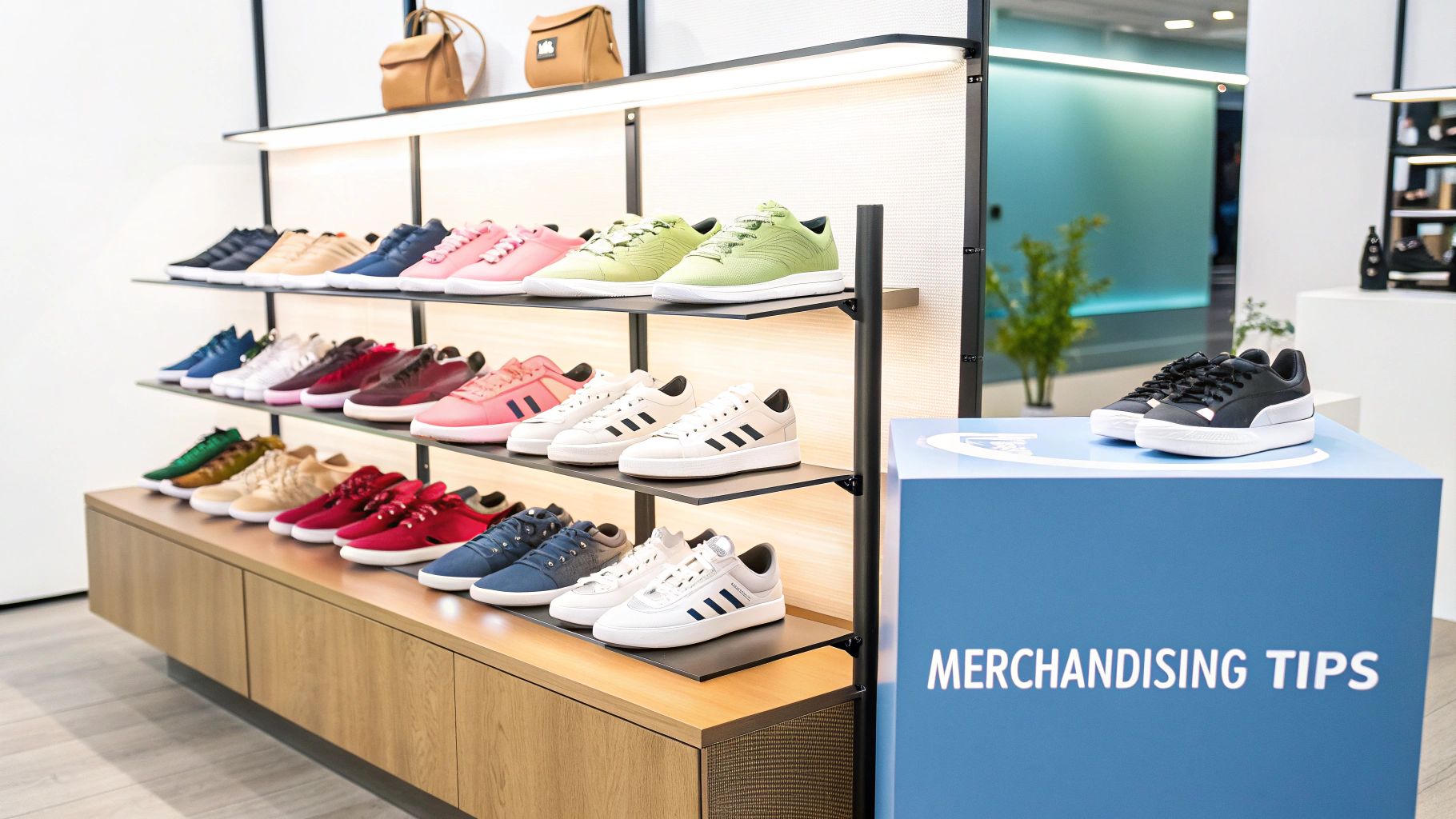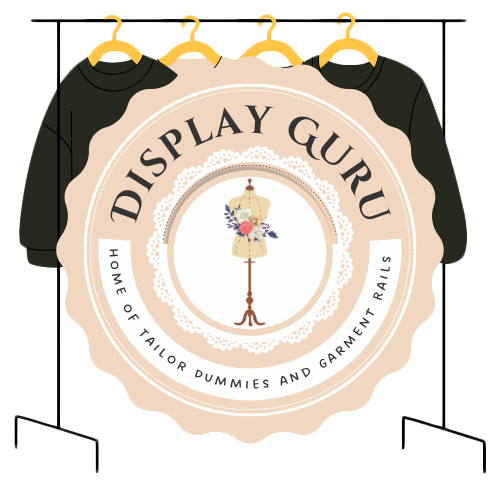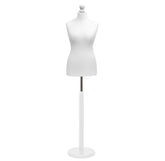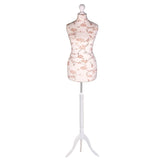Choosing Display Racks for Shoes
Let’s be honest, a pile of shoes shoved in a corner isn't going to get anyone excited to buy. The right display racks for shoes, on the other hand? They do the selling for you. Think of them less as simple furniture and more as your store's silent salesperson, highlighting your best products and steering customers from the moment they step inside.
Why Your Shoe Display Is Your Best Salesperson
Picture this: you walk into two different shoe shops. In the first, shoes are crammed into bins or lying flat on cluttered, messy shelves. It’s chaotic. The second shop displays each pair with care on a clean, well-lit rack, angled just right to grab your attention. Which one makes the shoes look more valuable?
It's a no-brainer. Your display is often the very first impression a customer has of your products. It sets the stage for their entire shopping experience. A confusing or disorganised layout is like a poorly designed website—people will just turn around and leave. Good shoe racks create a clear path, guiding customers through your collection and turning a simple shopping trip into a real discovery.
The Psychology of a Great Display
A well-thought-out display does more than just hold your stock; it taps into the customer's mindset to boost sales. It projects an air of professionalism and order, which builds immediate trust in your brand. When shoes are presented like premium items, customers automatically see them as having a higher value and are far more willing to spend.
This is the core of visual merchandising. As our in-depth guide on visual merchandising guidelines explains, a strong presentation can have a massive impact on buying decisions. Here’s how it works:
- It Reduces Decision Fatigue: By grouping similar styles or creating curated looks, you make it easy for customers to find what they want. The whole process feels smoother and more pleasant.
- It Creates Aspiration: A beautiful display helps customers imagine themselves wearing the shoes. It shifts the purchase from something practical to something desirable.
- It Encourages Impulse Buys: Putting your eye-catching new arrivals or best-sellers on a prominent stand is a classic way to capture attention and spark those unplanned purchases.
From Shelves to Sales Generators
At the end of the day, every single thing in your shop should be working towards one goal: increasing sales. Your display racks are a fundamental part of that strategy. They don't just hold shoes; they actively sell them by communicating quality, simplifying the customer's journey, and making your collection look completely irresistible.
For more inspiration on making every part of your display work harder, have a look at these actionable business sign ideas that can work alongside your product stands. This guide will give you a clear path for choosing and setting up the perfect display solutions for your own unique space.
Exploring the Main Types of Shoe Display Racks
Stepping into the world of retail fixtures can feel a bit overwhelming at first, but getting to know the main types of display racks for shoes is your first real step toward creating a space that works. Think of each style as a different tool in a toolkit—they all have a specific job to do. The rack you choose will completely shape how customers interact with your products and what they think of your brand.
This isn't just about what looks good; it's a strategic move. Your choice affects everything from floor space and stock capacity to the overall shopping experience. And with the UK's footwear market showing no signs of slowing down, smart visual merchandising has never been more critical. The market was valued at USD 7,910.98 million and is projected to hit USD 11,380.98 million by 2032, so presenting your stock in the best possible light is essential for grabbing a piece of that pie. You can read more about this on credenceresearch.com's UK footwear retailing market report.
As this infographic shows, the right display does far more than just hold shoes. It's an active part of your sales strategy.

A well-chosen rack builds your brand, guides the customer, and ultimately elevates the perceived value of your products. It's a silent salesperson working for you around the clock.
To help you navigate the options, here's a quick comparison of the most popular choices. It should give you a good starting point for figuring out what fits your space and your goals.
Quick Comparison of Shoe Display Rack Types
| Rack Type | Best For | Key Strengths | Potential Downsides |
|---|---|---|---|
| Freestanding | All-round versatility; shops that need flexible floor plans. | Easy to move and rearrange; no installation required; huge variety of styles. | Can take up valuable floor space; might look cluttered if not planned. |
| Slatwall | Boutiques with changing collections; maximising vertical wall space. | Highly customisable and modular; saves floor space; professional look. | Requires wall installation; initial setup can be more involved. |
| Wall-Mounted | Highlighting hero products; luxury or minimalist aesthetics. | Puts all focus on the shoe; creates an open, uncluttered feel. | Limited stock capacity; fixed in place, not easily moved. |
| Gondola | High-volume retailers; displaying a wide range of sizes and styles. | Massive stock capacity; durable and efficient for organising inventory. | Can look bulky and functional; less stylistic flair than other options. |
Each of these systems has its place, and the best choice often comes down to balancing your brand's aesthetic with the practical needs of your stock and floor plan. Now, let's look at each one in a bit more detail.
Freestanding Racks: The Versatile All-Rounders
Freestanding racks are probably what come to mind when you picture a shoe display. They're the reliable workhorses of retail, available in countless shapes and sizes—from simple tiered shelves to rotating towers. Best of all, they require zero installation. Just place them on the floor, and you're ready to start merchandising.
This flexibility is their superpower. You can completely rearrange your shop for a new season or a big sale without calling in a single contractor. That kind of portability keeps the shopping experience fresh and interesting for your regulars.
The trade-off? Their footprint can be a problem in smaller shops. A large freestanding unit holds plenty of stock, but it can also create awkward bottlenecks or make a cosy space feel cramped if you're not careful with your layout.
Slatwall Systems: The Modular Masterpiece
Imagine your wall is a blank canvas where you can click different display components into place like Lego bricks. That’s the beauty of a slatwall system. These grooved panels allow you to attach a massive range of accessories—from individual shoe shelves and hooks to baskets and sign holders.
Slatwall is the undisputed champion of customisation. You can change your entire display in minutes, shifting shelves up and down or spacing them out to perfectly fit everything from tiny sandals to chunky walking boots. This makes them a dream for boutiques that need to keep their visual story fresh.
The real magic of a slatwall system is its ability to turn a flat, boring wall into a three-dimensional, high-impact selling space. It makes the most of your vertical square footage, drawing the customer's eye upwards and making a small shop feel much bigger than it is.
If you're curious about how different fixtures can transform a space, take a look at our complete guide to display shoe racks.
Wall-Mounted Shelves: The Minimalist Choice
For a clean, contemporary, and almost invisible look, nothing beats wall-mounted shelves. These are often single shelves or small groups fixed directly to the wall, creating a "floating" effect that puts 100% of the focus on the shoe itself. This is the go-to approach for high-end boutiques wanting to present certain shoes as if they were pieces of art.
The minimalist aesthetic helps create a real sense of luxury and space. By keeping the floor completely clear, these displays make a shop feel more open and uncluttered—a huge advantage in smaller retail environments.
Of course, their capacity is limited by design. Wall-mounted shelves are all about showcasing a curated selection of "hero" products, not holding your entire inventory. They also require more commitment, as they're fixed in place and can't be moved on a whim.
Gondola Shelving: The High-Capacity Hero
Walk into any big department store or footwear superstore, and you'll be surrounded by gondola shelving. These are the robust, double-sided, freestanding units that create the aisles you walk down. They are built for one main purpose: to hold a massive amount of stock as efficiently as possible.
For retailers who need to display a huge range of sizes and styles in an organised fashion, gondolas are the ultimate solution. Their heavy-duty construction can handle serious weight, making them perfect for work boots, hiking shoes, and other substantial footwear.
But while they are incredibly practical, gondolas aren't exactly known for their stylistic flair. Their look is more functional than fashionable, making them a better fit for high-volume, discount-focused stores than for small, curated boutiques where every aesthetic detail counts.
How to Choose the Right Materials for Your Racks
The material you pick for your display racks for shoes does so much more than just hold your stock. It’s part of your brand’s story. Think of it as the first handshake with your customer – it instantly sets the tone for their entire experience, communicating everything from rugged durability to sleek, modern luxury.
Choosing the right material is really a balancing act. You have to weigh up aesthetics, how long it will last, how much cleaning it needs, and of course, the cost. Each option brings its own personality and practical challenges to the shop floor, making this a foundational decision for creating a space that feels right.
Metal Racks For a Modern Industrial Feel
In the world of retail fixtures, metal is a real powerhouse, loved for its sheer strength and versatility. Whether it's gleaming chrome or powder-coated steel, metal racks deliver a clean, industrial look that's a perfect match for urban, contemporary, or athletic footwear brands.
They're also incredibly tough and can handle heavy items like work boots without ever sagging or showing signs of strain. This resilience makes them a smart long-term investment.
- Chrome: Gives you a bright, reflective finish that feels modern and high-end. It’s fantastic for grabbing attention, but it does show fingerprints, so be prepared for regular polishing.
- Powder-Coated Steel: This option comes in a massive range of colours, so you can easily match your racks to your brand identity. The finish is tough as nails, resisting chips and scratches far better than standard paint.
- Wrought Iron: If you're going for a classic, artisanal vibe, wrought iron is a great choice. It's ideal for bespoke or vintage-inspired boutiques, and its sheer weight gives a feeling of permanence and quality.
Wooden Racks For Warmth and Craftsmanship
Nothing brings a natural warmth and an organic feel to a retail space quite like wood. It has a unique way of communicating quality, tradition, and craftsmanship. From rustic pine to sophisticated oak, wood is wonderfully adaptable to different brand aesthetics.
The specific wood and its finish are key. A light, unfinished pine creates a friendly, approachable atmosphere, while a dark-stained mahogany suggests luxury and heritage. The only real downside is that wood can be more prone to scratches and dents than metal, so it’s better suited for environments where it’ll be treated with a bit of care.
One of the biggest advantages of wood is its timeless appeal. Retail design trends come and go, but a well-crafted wooden display rack rarely looks dated. It’s a solid investment for your brand's image.
For a more hands-on approach, you could even build your own simple wooden shoe rack. You’ll find plenty of tutorials online showing how to use basic pine boards and pocket hole screws to create a customised solution that fits your space and needs perfectly.
Acrylic Racks For a Clean and Minimalist Look
If you want your shoes to be the undisputed star of the show, acrylic is your best bet. These clear plastic racks create a cool "floating" effect, making the footwear look like it's suspended in mid-air. This minimalist approach is perfect for luxury boutiques or displays featuring brightly coloured trainers where the product needs to shine without any distractions.
Acrylic is also lightweight and generally less expensive than glass, which has made it a popular choice for modern displays. It refracts light beautifully, which can help your entire display area feel brighter and more open.
The main drawback? Maintenance. Acrylic scratches more easily than glass and can be a bit of a dust magnet due to static electricity. It needs careful cleaning with specific products to stop it from going cloudy, so it’s definitely a higher-maintenance option.
Glass Shelving For High-End Elegance
For an unparalleled level of sophistication, it has to be glass. Just like acrylic, it offers a transparent display that puts all the focus on the product. But glass has a premium weight and clarity that acrylic can’t quite replicate, projecting an image of pure luxury.
Paired with sleek metal brackets, glass shelving is a hallmark of high-end retail. It’s the perfect stage for showcasing premium heels, designer dress shoes, or limited-edition releases. If you’re looking to create a truly premium showcase, exploring a display cabinet with glass can be a fantastic way to both protect and highlight your most valuable items.
Of course, the big concerns with glass are its fragility and weight. You absolutely need to use tempered glass for safety, but even that can chip or break from a heavy impact. It also needs constant wiping to stay free of smudges and fingerprints, demanding a lot of upkeep to maintain that pristine, crystal-clear look.
Planning Your Layout to Maximise Space and Sales
Think of your shop layout like a well-designed website. The customer’s journey from the front door to the till should feel completely natural and effortless. Before you even think about building your first display, you need a solid plan. This blueprint phase is what separates a great retail space from a cluttered one; it prevents costly mistakes, makes the most of every square foot, and turns your floor plan into a silent, effective salesperson.
The aim isn't just to cram in as many display racks for shoes as possible. It's about creating a comfortable, engaging atmosphere that encourages people to stick around, explore, and ultimately, make a purchase. A thoughtfully planned layout can make a huge difference in how long shoppers stay and can gently guide their eyes towards your star products.

Measuring and Mapping Your Space
First things first: you need to know exactly what you're working with. Grab a tape measure and sketch out a simple floor plan of your retail area. It doesn’t need to be a professional blueprint, but it does need to be accurate.
Be sure to mark the locations of all the permanent features that will dictate where you can and can't place your displays.
- Entrances and Exits: Pay attention to how doors swing and the clearance they need.
- Windows: These are fantastic for high-impact displays but remember the sun can damage certain materials over time.
- Support Columns: You have to work around these, so get them on the map.
- Power Outlets: Absolutely vital for any illuminated displays or digital screens.
- Fire Exits and Safety Equipment: These areas must be kept clear at all times. No exceptions.
With these fixed points mapped out, you can start to imagine how customers will move through the shop. This "customer flow" is probably the single most important part of your layout design.
Designing an Intuitive Customer Journey
Put yourself in your customer's shoes. How will they naturally move when they walk in? Most people have a tendency to turn right when entering a shop. Use this to your advantage! Place your most exciting new arrivals or a show-stopping "hero" display right there to grab their attention.
The main pathway through your store should be obvious and easy to follow. You want your aisles to be wide enough for people to browse comfortably without bumping into each other or feeling hemmed in. As a general rule, aim for at least 90-120 centimetres for your main walkways.
Your layout should tell a story. Group related items together. For instance, put your shoe care products next to your leather boots, or position sports socks right by the trainers. This kind of logical pairing just makes sense to a shopper and is a brilliant way to encourage those valuable add-on sales.
By creating these deliberate product zones, you build a seamless shopping experience. The customer feels like they're being guided through carefully curated collections, making it easy and enjoyable to find what they're looking for. For more ideas on this, our guide on effective store display ideas has plenty of extra tips.
The Critical Pre-Installation Checklist
Before you lock in the final layout and start bringing in the fixtures, run through this quick checklist. A few minutes spent thinking about these practical points now can save you a world of headaches down the line.
- Check Wall Strength: Are your walls sturdy enough for heavy, wall-mounted shelving? If you’re using slatwall, make sure it’s properly fixed to the wall studs, not just the plasterboard.
- Assess Floor Level: Is the floor completely flat? An uneven surface can make freestanding racks wobble, which is a real safety risk. Fixtures with adjustable feet can be a lifesaver here.
- Confirm Lighting: Where are your main light sources? The last thing you want is a tall rack casting a huge shadow over other products, creating dark and uninviting corners.
- Accessibility: Can a customer with a pushchair or in a wheelchair navigate your shop easily? Wide, clear paths are not just a legal must-have; they’re a fundamental part of good customer service.
- View from the Entrance: Finally, stand right at your shop’s front door. What’s the very first thing you see? That initial view needs to be clean, welcoming, and instantly communicate what your brand is all about.
Bringing Your Vision to Life with Smart Merchandising
So, you’ve chosen the right materials and mapped out your layout. Those are the foundations, but the real magic happens when you start merchandising. Having the perfect display racks for shoes is only half the battle; it's how you arrange your products with a bit of creativity and strategy that really stops people in their tracks and gets them buying. This is where you turn a simple fixture into a compelling story.
It all starts with a safe and secure installation. Before you even think about aesthetics, you have to be sure your racks are solid. If you're using freestanding units, give them a good wobble test – many come with adjustable feet to sort out any uneven floors. For wall-mounted systems like slatwall or floating shelves, it's crucial to fix them into the wall studs, not just the plasterboard. You need that guarantee they can handle the full weight of your stock.

Creating Visually Appealing Arrangements
Once your racks are firmly in place, it's time for the fun part. The aim here is to create displays that aren’t just organised, but are visually exciting enough to make customers slow down and take a closer look. A well-thought-out display can genuinely elevate how people perceive your products.
Think of yourself as a storyteller. What’s the narrative you want to build? Are you launching a new seasonal collection, putting a spotlight on a particular brand, or showcasing a style trend? When you group products logically, you help customers browse with ease and find inspiration along the way.
Here are a few tried-and-true techniques:
- Colour Blocking: This is a classic for a reason. Arranging shoes in bold blocks of similar colours creates a powerful, harmonious effect that can draw the eye from clear across the shop floor.
- Style Grouping: Keep like with like. Create a dedicated zone for trainers, another for formal shoes, and one for sandals. It just makes sense for the customer who walks in knowing exactly what they need.
- Alternating Placement: It’s a simple trick, but it works. By alternating shoes heel-to-toe on a shelf, you can often squeeze an extra pair onto each row while making the whole display feel more dynamic.
The Power of the Hero Display
Every retail space needs a showstopper—a "hero" display designed to make customers stop and stare. This is where you showcase your most exciting stock: the bestsellers, the new arrivals, or the items with the best margins. This display needs to be in a high-traffic spot, ideally near the entrance, to make an instant impact.
Use your best-looking display rack for this and give the products plenty of breathing room. An overcrowded hero display just looks desperate; you want each shoe to feel special and important. This focused presentation is a clear signal to customers: these are the items worth paying attention to.
A strong hero display acts as a visual anchor for your entire store. It sets the tone, communicates your brand's style, and can single-handedly drive a significant portion of your sales for key products.
With UK households spending around £13.5 billion on footwear in a recent year, the fight for customer attention is intense. Putting time and effort into creating standout displays is no longer a 'nice-to-have'—it's essential for grabbing your slice of the market.
Enhancing Your Displays with Lighting and Signage
Finally, don't overlook the details that pull everything together, like lighting and signage. These elements are what transform a standard rack of shoes into a captivating product showcase. Great merchandising isn't just about the product; it's about the whole presentation.
Try using focused spotlights to highlight your hero displays or add LED strip lighting under your shelves to make each shoe pop. The right light creates depth, adds a touch of drama, and simply makes your products look more desirable. In the same way, clear, simple signage is vital. Use it to communicate prices, promotions, or key features without making the display look cluttered.
To really bring your merchandising into the modern era, think about integrating technology. Digital screens showing product videos or promotional content can add a dynamic layer to your static displays, catching the eye and engaging customers. Explore top digital signage solutions for retail success to see how you can blend the physical and digital for a truly powerful in-store experience.
Common Questions About Display Racks for Shoes
Choosing the right display racks for shoes is a big decision for your shop or home studio, so it's completely normal to have a few last-minute questions. You're making an investment, and you want to get every detail right. We get it.
This section is all about tackling those common queries we hear day in, and day out. Think of it as your final checklist to run through before you commit, giving you total confidence that you've covered all the bases.
How Do I Clean and Maintain My Shoe Racks?
The best way to keep your racks looking sharp really comes down to what they're made of. A pristine display makes your products look their best, so a little regular upkeep goes a long way.
For metal racks, particularly anything with a polished chrome finish, a soft microfibre cloth is your secret weapon against fingerprints and smudges. If you’re dealing with something a bit more stubborn, a gentle, non-abrasive cleaner will do the trick. For wooden racks, a regular dusting and the occasional treatment with a good wood polish will keep them from drying out and maintain that lovely lustre.
Acrylic and glass displays need a bit more TLC. Always reach for a proper plastic or glass cleaner and a fresh microfibre cloth to avoid scratches on acrylic or streaks on glass. And a word of warning: steer clear of harsh, ammonia-based chemicals, as they can ruin the finish over time.
Here's a simple but effective tip: set up a weekly cleaning schedule. Just a few minutes of care each week stops dust and grime from building up, keeping your shoe displays looking brand new.
What Is the Average Capacity of Different Rack Types?
This is a big one, as capacity can vary massively from one style to another. A common pitfall is falling for a rack's aesthetics without thinking about whether it can actually handle your inventory.
Here’s a rough guide to give you an idea:
- Wall-Mounted Shelves: These are your showstoppers, not your workhorses. You’ll comfortably fit 1-3 pairs per shelf, which makes them perfect for spotlighting your hero products.
- Freestanding Tiered Racks: A standard three or four-tier unit will typically hold somewhere between 12 to 20 pairs of shoes, depending on their size and style.
- Slatwall Systems: The beauty of slatwall is its flexibility. The capacity is entirely up to you—fit as many individual shoe holders as your wall space allows.
- Gondola Shelving: These are the undisputed champions of capacity. A single, standard-sized gondola unit can easily hold 50-100+ pairs of shoes, making it the obvious choice for high-volume retail.
How Much Weight Can a Wall-Mounted Rack Hold?
This is a critical safety question. The weight capacity of a wall-mounted rack or a slatwall system has less to do with the fixture itself and more to do with the quality of the installation and the strength of the wall.
When fixed securely into solid wall studs with the right hardware, a rack can hold a surprising amount of weight, easily supporting heavy walking boots or multiple pairs of shoes. However, if that same rack is only attached to plasterboard with standard wall plugs, its capacity plummets, and it can become a serious hazard.
Always follow the manufacturer’s instructions to the letter. If you have even the slightest doubt, it’s worth hiring a professional to ensure the installation is rock-solid. It’s far better to be safe and distribute heavy stock across several fixtures than to risk overloading one.
Can I Mix and Match Different Types of Racks?
Absolutely! In fact, mixing different types of display racks for shoes is often the secret to creating a really dynamic and engaging shop floor. Combining styles adds visual interest and helps you carve out different zones within your space.
For instance, you could use sleek wall-mounted shelves by the entrance to showcase new arrivals, place versatile freestanding racks in the main area for your core collections, and use a high-capacity gondola for your sales section. This kind of thinking extends to other product categories, too. For more ideas on this, our guide on choosing the right display stands for clothing explores similar merchandising strategies.
The trick is to keep a consistent feel through your choice of materials or colours. A mix of wooden and black metal racks, for example, can look incredibly cohesive and intentional. A random assortment of clashing styles? Not so much. A thoughtful combination is what separates good visual merchandising from great.
At Display Guru, we provide a wide range of high-quality display solutions to help you create a professional and effective retail environment. Explore our collection of garment rails, body forms, and other essential display tools to bring your vision to life. Visit us at https://www.displayguru.co.uk to learn more.








